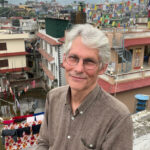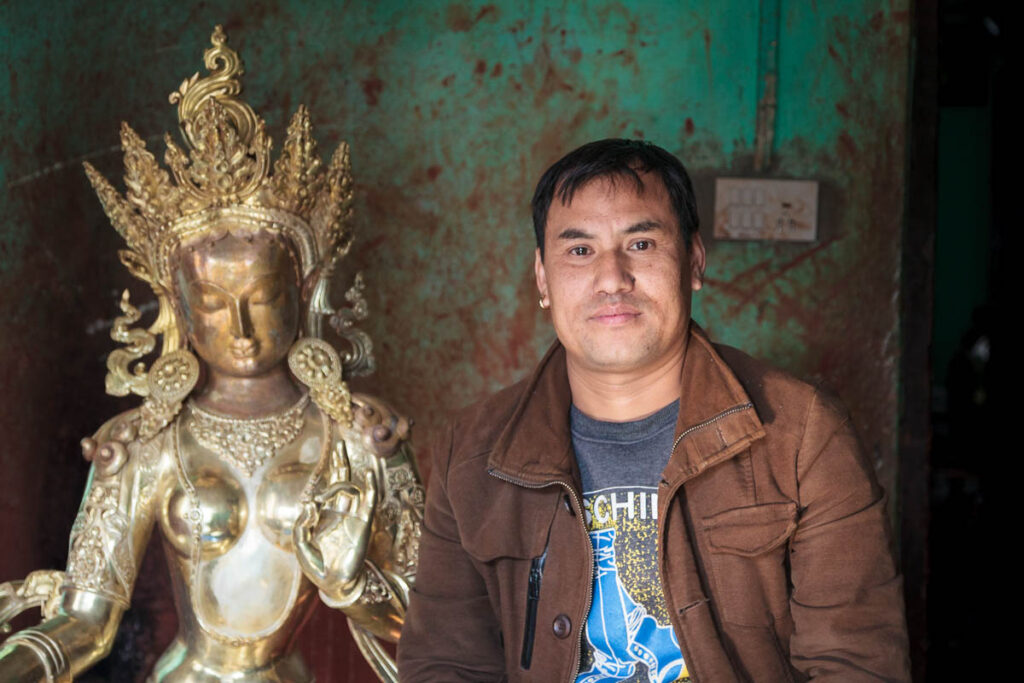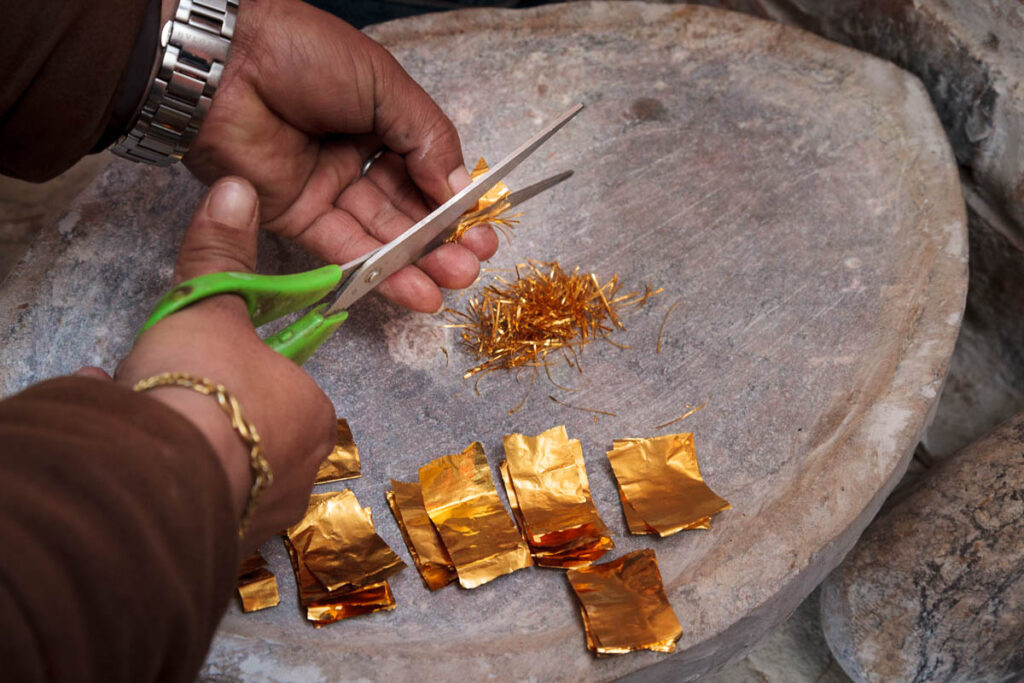
The gold coating comes to its full lustre after the mixture containing mercury is heated with a blowtorch. Here the craftsman is inspecting the finish after the firing has been completed.
Gary Wornell visits a legendary Nepalese gilder and witnesses the mysterious alchemy that turns idols golden.
Ram Krishna Prajapati’s gilding workshop is at the top of his five-storey house on a back street of Patan. I’m riding across town on my bicycle from my apartment in Lazimpat early in the morning – camera bags, helmet and a facemask strapped on tight against the toxic fumes from the heavy morning traffic. I have on my Arctic down jacket and leather gloves against the cold. Winter nights can get really icy in Kathmandu and when I started out, even with the gloves on, I was freezing.
I was curious to see Ram’s place and Pradiip Maharjan, the sculptor, arranged to take me. Everywhere you go in Nepal you find gold. Every temple, every monastery, has statues of gods both Hindu and Buddhist. The lines between these two religions seem to be fuzzy at the edges, especially in Nepal and the Nepalis I have met don’t bother much with the details. In any case, gold is the metal of the gods and deities and it is used in its purest 24-carat form. Gold is also a sign of wealth in most communities here in Nepal, and women often keep gold at home as a readily tradable commodity. A woman who wears gold is a woman of status and every street in the city has at least one small shop selling gold jewellery.
Once I’m over the Bagmati River the worst is behind me, and the ride through the old city is always a joy. I navigate the cramped streets lined with shops selling thangka and tee-shirts and stuff for the tourists, past Patan Durbar square with its brick paved roads and ancient temples and through the narrow alleyways down the hill towards the ring road. By the time I reached Pradiip’s house, I am sweating underneath the layers as the day has suddenly turned warm in the bright sun.
- Ram Dai – Master Guilder
- Mercury has been added to the gold strips after which grinding will create the liquid used to coat the copper castings.
- 24 carat gold is cut into thin strips prior to be mixed with mercury.
- Burning off the mercury outside in the open air to leave the gold plating bonded to the bronze.
- A craftsman brushes the gold mixture into a small area to improve the lustrous surface.
- Unfinished works in various stages of completion sit on a tiled shelf and on the floor of Ram dai’s workshop.
- A large sculpture is moved from the terrace back into the gilding room where a second coating of gold will be applied.
- Brushing additional fresh gold mixture onto a large sculpture where the gold needs more thickness.
Cycling is by far the fastest way to get around town. Kathmandu traffic doesn’t obey any rules and horns are used more than direction indicators to clear the path ahead. Given the density of the traffic in the early morning, the horn doesn’t help much, but that doesn’t seem to deter the drivers from using them. Between the motorcycles, scooters, cars, lorries and public transport vehicles – oh, and random jaywalkers – it can be a pretty hazardous journey from one side of town to another. On the south side of Patan, the small roads are mostly clear and in minutes I’m opening the corrugated iron gate to Stupa Handicrafts and Pradiip’s house. My two assistants are already there having tea and soon we head off with Pradiip on two motorbikes to Ram’s workshop.
The lane where Ram lives and works is too narrow for parking, so we stop around the corner and happen upon him and a couple of his workers with a life-size statue of a god in the lotus position, outside a welder’s having some small repairs done. The bright gold of the god looks surreal in the intense sunlight, steam rising from the heated metal as he pours cold water on the joint. He inspects the work, says something to the workers, and he and the men promptly pick up the statue and return to the workshop.
When we arrive at the steps to the house, someone is already waiting at the window on the second floor and throws the door key down to us on a long string. It dangles in front of the lock, and after we let ourselves in the key disappears up in the air and through the window.
Ram has been a gilder for more than 18 years now. Before he learned the craft he had kept a grocery shop locally. It was his wife who had practised the craft and soon after they got married he began to learn it and quickly developed a passion for the fine art of gilding. For a few years, the two of them worked together until the business began to pick up. Their work stood out from the others—quality and finish were well above the competition, and soon he was employing five craftsmen, then seven and now he has 15 people working for him.
The gilding is done at the top of the house in an open space where the air circulates freely. I’m already concerned about the use of mercury—especially as it will be burned out with a torch—and keep my mask on as a precaution. Climbing the stairs to the roofed terrace I can hear a popular Hindi song playing on the radio – a sound you hear all over Nepal in taxis and restaurants and roadside shops. Three workers, one of them singing along to the tune underneath his facemask, are sitting on a straw mat in front of a large flat decorative casting. Stainless steel dishes have drops of the liquid gold paint in them, and the men are using fine wire brushes to work the liquid into the details. The man in charge of handing out the gold sits in a corner of the room, measuring out small beads of paint into a bowl on a balance until the pointer rests in the centre, and then hands the container to a worker.
Outside in the open air the sound of a gas torch cracks and hisses to life. I walk across the landing at the top of the stairs and out into the bright sunlight. On a clear day, from the top of this building, the white peaks of the Himalayas can be seen rising above the dark green of the hills of Sindupalchok to the north and stretching as far as the eye can see to the East and West. But today, like so many days in Kathmandu, the pollution of the city fogs the skyline and I only imagine that I can see them.
Two workers are firing the bright gold of another large flat sculpture against the low concrete wall, each working from the outer edges towards the middle. In broad sweeping strokes the blue flames leap back and forth over the elaborate carved surface, while the men holding white cotton rags and wire brushes burnish the surface until the yellow-white metal appears. I’m in awe of the process – from the brown wax models made by Pradiip and his craftsmen to the sanding, carving and polishing, to the transformation by fire into solid metal forms and finally emerging here clothed in shiny gilt.
When the sculptures come here they are first heated and given a bath in sulphuric acid to clean the surface. After that, the gilding can begin. Ram prepares the thin sheets of gold by cutting them into fine strips onto a heavy stone grinding block. Fluorescent light bulbs, used to make the paint smooth, are smashed and ground along with the gold into a fine powder before mercury is added. One part gold to fifteen parts mercury and some glass from the light bulbs are ground into a dark silver liquid before being measured out for a sculpture. Ram calculates the exact quantity of gold required and writes it into a ledger for the record.
Few people in Nepal have a licence for buying mercury: the sale is controlled by the state and the health hazards are well known to Ram dai’s workers. A minimum of three coats must be applied for the best finish. The heat is maintained until all the mercury has burned away and the surface is continuously cleaned during the process. Finally, the sculpture is washed with soap and water. Red clay is then brushed over the god and rinsed off, highlighting the folds and details of the work.
Ram dai’s wife appears at the door of the terrace and motions for me to go downstairs to where they live. Two floors below and underneath Ram’s office is a bright green room with a couple of beds, a tall wooden clothes cupboard and a low table by the window. High up near the ceiling above one of the beds are some framed certificates and a wall fan. The certificates are too high to read from the floor and, lost in my own thoughts for a moment, I find myself wondering why it is that Nepalis hang pictures and things like this way above the head level where you can’t see them. The TV is on in the corner of the room and their two boys are playing together and watching a cartoon.
I sit with them for a while. We eat fresh watermelon. I take a few photographs of the family – Ram posing on the bed with his wife and sons and notice the boys’ faces in my camera; the beautifully carved lips and almond-shaped eyes have the same features as those of the gilded gods.












Comments
Exquisite work and craftsmanship !
Thanks of sharing.